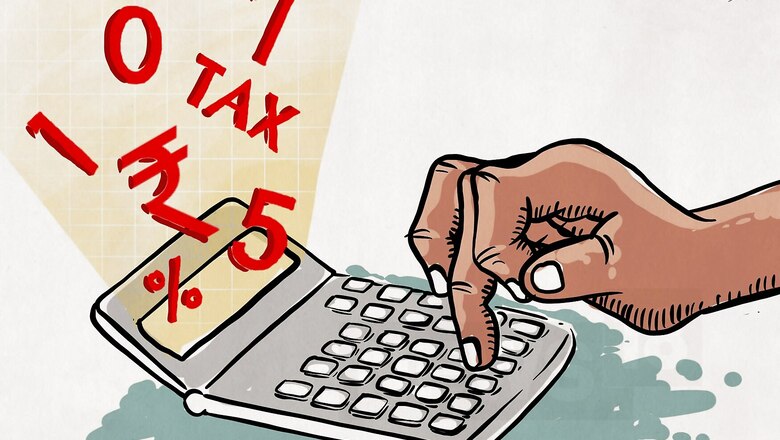
views
The loud cheers over the Narendra Modi government’s bold income tax proposal, to exempt those earning up to Rs 5 lakh in annual taxable income from any tax, have already given way to cynical shakes of the head.
Lok Sabha had erupted into a loud cheer, with the Prime Minister joining others in thumping his desk enthusiastically, when Finance Minister Piyush Goyal announced during his Budget speech on Friday morning that the salaried class will be given such a relief. It is only after the initial euphoria died down that experts explained this proposal for what it is: a possibility of some relief but nothing immediate and not on income earned in 2018-19. Also, this proposal (like other direct tax proposals) will still need to be approved by the new government, so till then it is best to treat this as a possibility, not certainty.
The finance bill explains this new proposal thus: “Clause 8 of the Bill seeks to amend section 87A of the Income-tax Act to provide relief to the individual taxpayers by increasing the maximum amount of tax rebate to twelve thousand five hundred rupees from existing two thousand five hundred rupees. The tax rebate shall now be admissible to taxpayers having total income up to five hundred thousand rupees, instead of existing three hundred fifty thousand rupees.”
Right after the Budget speech, Economic Affairs Secretary SC Garg started the confusion when he told CNBC-TV18 repeatedly that the provision applies to income earned in 2018-19, the current fiscal year. “The deduction for taxable income up to Rs 5 lakh will come as a rebate in 2019-20. It is for income earned in 2018-19.” Garg also said the changes in direct taxes would be applicable from April 1 this year.
But Girish Vanvari, Direct Tax Head at KPMG said, “The celebration with regard to rebate up to Rs 5,00,000 looks to be a little exaggerated. This is applicable to income up to Rs 5 lakh as a rebate and also only for the next year. It should also be noted that when the full Budget comes, things can once again change from April 1, 2019”.
A legitimate question then is, does anyone earning, say Rs 5.5 lakh, also get some relief? No, say experts, adding that if the taxable income in a year exceeds Rs 5 lakh, then existing income tax slabs apply. So any relief at all is only for those whose taxable income is Rs 5 lakh or less.
Second, even such individuals who are eligible for this concession have to anyway file their I-T returns. The relief will come as a rebate, after the returns have been filed. This could theoretically mean any relief could be many months away and TDS (tax deducted at source) may not be adjusted immediately as the new fiscal begins.
Some other direct tax proposals were also made by Goyal. These include raising standard deduction from Rs 40,000 to Rs 50,000, which should provide additional tax benefit of Rs 4,700 crore; no income tax on notional rent on a second self-occupied house; TDS threshold on interest earned on bank/post office deposits raised from Rs 10,000 to Rs 40,000; TDS threshold for deduction of tax on rent hiked from Rs 1,80,000 to Rs 2,40,000.
Why the middle class salaried Indian is crucial to the government’s revenues is amply clear: A major portion of the personal income tax collection comes from the salaried class. For assessment year 2016-17, the average tax paid by a salaried individual was almost three times that paid by an average businessman. Here are the numbers: For assessment year 2016-17, 1.89 crore salaried individuals filed returns, paying total tax of Rs 1.44 lakh crore or average tax payment of Rs 76,306 per individual salaried taxpayer. But of the 1.88 crore individual business taxpayers, including professionals, total tax was just Rs 48,000 crore or average tax payment of Rs 25,753 per individual business taxpayer. So while similar number of individual salaried Indians and businessmen paid taxes, the amount paid varied to such an extent. The salaried class, along with pensioners comprises 25-30% of total tax base or every third income taxpayer is either a salaried individual or a pensioner.
Not to mention the fact that this section comprises an important and large chunk of the vote-bank for any political party. With elections round the corner, the Modi government could not have ignored the middle class --even though what has been offered is a sort of mirage.
In fact, Goyal’s speech was more a laying down of the BJP’s election manifesto rather than a Budget speech. A quick analysis of the Budget speech by Goyal reveals that he tried not to commit the same mistakes as his predecessor. On Budget day last year, Arun Jaitley had used the word ‘farmer’ 27 times and the word ‘agriculture’ 29 times. The country’s poor too had got a mention 21 times but the salaried, people who diligently pay taxes, were referred to just seven times. The Budget last year had been panned by the middle class as being insensitive to their travails.
But this time, Goyal not only used the phrase ‘middle class’ 14 times in his speech and the word ‘taxpayer’ 11 times, he also announced this proposal to exempt those whose total taxable earning was up to Rs 5 lakh in a year from paying any income tax at all.
Goyal waxed eloquent about the taxpayers and the enormous help they provide in the government’s efforts to reach welfare schemes to the poor and the marginalised. Only, less than six crore people paid taxes last year from the almost 130 crore population of this country. That’s about 5.3% or just about every 20th Indian. Perhaps more than catering to middle class aspirations, the government needs to worry about expanding the tax payers’ base. It claims to have doubled this base since 2014 to 6.35 crore tax payers.
(The author is a senior journalist. Views are personal)



















Comments
0 comment